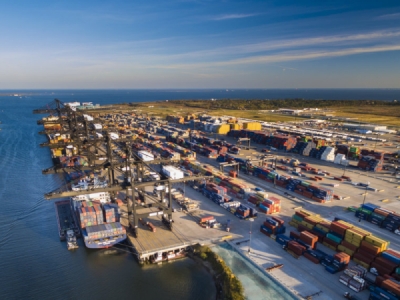
Posted on April 15, 2019
Anyone up for some ‘Texas Chicken’? Maybe not anymore as pilots request one-way traffic for big ships on busiest hub in North America.
Port Houston’s move to limit traffic for larger container ships to once a week may put a damper on growing volumes trade out of the Gulf Coast. The shipping restriction adds to another recent change in rail service that hit outbound logistics from the nation’s busiest port for foreign trade.
Last week, Port Houston’s commissioners approved a rule that vessels imposing “one-way traffic” restrictions when transiting the port will be limited to one terminal call per week.
The Houston Pilots, which guide deep-water ships in and out of the Houston Ship Channel, had asked for the rule that all ship traffic go in only one direction when they are maneuvering ships of 1,100 feet.
A spokesman for the Houston Pilots said the request was due to the depth and width restrictions on the winding, 52-mile long Channel. Two ships passing in opposite directions creates what pilots call the “Texas Chicken” where the wakes push the ships apart, then rapidly pushes them closer together again.
But oil and gas companies also support the move since one-way traffic restrictions limited the number of vessel calls at the plants and terminals that line the Houston Ship Channel.
In fact a group of oil and gas companies banded together as the Coalition for a Fair and Open Port to argue in favor of the one-way vessel restriction.
The largest tanker that can call at a terminal at the Port Houston is typically 950-foot long.
In contrast, the largest container ships that are now calling on Port Houston terminals are 1,100 feet or more in length.
The Bayport Terminal said that four of the 11 container ships on the Indus Service run by Mediterranean Shipping Company (MSC) are subject to one-way traffic. MSC was unavailable to comment on the restriction.
Todd Stewart, President of Houston-based third-party logistics firm Gulf Winds International, said the bulk of container ships coming into Houston are below that size, so he does not expect a major volume impact from the restriction.
But the restriction does point out the need for a bigger channel to meet the needs of the energy industry and the growing container trade. Port Houston, which handled just over 1 million twenty-foot equivalent units (TEUs) last year, has capital spending projects to bring annual capacity up to 3 million TEUs.
“The bigger goal is that we need a deeper and wider channel,” Stewart said. “The volumes coming into the port are not going to take a massive hit from this.”
Port Houston “is trying to find something that works for both sides and is good for the Houston region.”
There is more demand for outbound ocean shipping from the Gulf Coast due to the opening of new plastics manufacturing plants in Houston. Resins and plastics exports at 308,270 twenty-foot equivalent units (TEUs) saw the highest absolute growth of any export out of Houston last year.
Due to the availability of low-cost feedstocks from nearby Houston petrochemical plants, companies such as Ravago Chemicals and Vinmar have set up large distribution sites in Houston to package resins and plastics for export markets.
Resins and plastics exports make the Gulf Coast one of the few “balanced” markets in terms of containers coming in and going out loaded, said Howard Finkel, vice president for Cosco Shipping Holdings (HKEX: 1919). Speaking about the Gulf Coast market at a recent conference, Finkel said exporters will be looking at higher rates if they want more vessel capacity out of the Gulf Coast.
“If you have this explosion of resin coming from the Gulf Coast, the exports are going to overtake the imports. For us to make decisions on bigger vessels and more containers coming into the Gulf Coast, you are going to have to pay headhaul rates,” Finkel said.
Resin and plastics manufacturers are also looking at moving products inland through Dallas and to the East Coast. But the ability to do so took a hit as Union Pacific (NYSE: UNP) ended a rail service linking Houston to Dallas at the beginning of April.
The end of that service pushed more shippers to look for truckload capacity, Stewart said. The switch pushed the Outbound Tender Volume Index for Houston (SONAR: OTVI.HOU) to reach a six-month high at the start of this month.
Union Pacific did not say why it ended the service, but insufficient volume was likely the culprit, Stewart said. Not that he’s complaining as Gulf Winds is “seeing a major uptick” in trucking and trans-loading demand from the switch, Stewart said. The uptick includes resin and plastics shippers, who may yet produce enough volumes that rail service will return.
“It’s an opportunity for us, but in the long-term there should be some rail opportunity as well,” Stewart said.
Source: freightwaves.com





